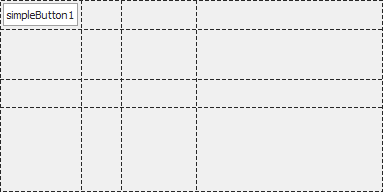TablePanelEntityStyle Enum
Enumerates size types for rows and columns in the TablePanel.
Namespace: DevExpress.Utils.Layout
Assembly: DevExpress.Utils.v21.2.dll
NuGet Packages: DevExpress.Utils, DevExpress.Win.Design, DevExpress.Wpf.Core
Declaration
Members
| Name | Description |
|---|---|
AutoSize
|
Rows/columns are automatically sized to match their contents. The Width and Height settings of these columns/rows are ignored. You can also enable the TablePanel’s AutoSize property to automaticaly resize the panel to fit its contents. |
Absolute
|
A row/column has a fixed width/height, in pixels. If the last row/column is of the Absolute size type and the TableLayout provides more space than needed, the row/column is stretched to fit this space. |
Relative
|
Rows/columns of this size type divide the available space according to the ratio specified by their sizes. When you enable the TablePanel’s AutoSize setting, Relative mode is equivalent to AutoSize mode. |
Related API Members
The following properties accept/return TablePanelEntityStyle values:
Remarks
Use the Style property to specify the size type for a row/column in the TablePanel.
tablePanel1.Rows[1].Style = DevExpress.Utils.Layout.TablePanelEntityStyle.Absolute;
tablePanel1.Rows[1].Height = 50;
The TablePanel may contain rows and columns of different size types simultaneously. In this case, available space is distributed between rows and columns in the following order.
- First, space is allocated for rows/columns of the Absolute type.
- Second, space is allocated for rows/columns of the AutoSize type.
- Finally, the remaining space is distributed among rows/columns of the Relative type.
Example
The following example adds rows and columns to a TablePanel, and then places a button to the panel’s top-left cell.
The created rows and columns are of different size types, as demonstrated in the image below.

using DevExpress.Utils.Layout;
tablePanel1.Columns.Clear();
tablePanel1.Columns.Add(new TablePanelColumn(TablePanelEntityStyle.AutoSize, 0));
tablePanel1.Columns.Add(new TablePanelColumn(TablePanelEntityStyle.Absolute, 40));
tablePanel1.Columns.Add(new TablePanelColumn(TablePanelEntityStyle.Relative, 2));
tablePanel1.Columns.Add(new TablePanelColumn(TablePanelEntityStyle.Relative, 5));
tablePanel1.Rows.Clear();
tablePanel1.Rows.Add(new TablePanelRow(TablePanelEntityStyle.AutoSize, 0));
tablePanel1.Rows.Add(new TablePanelRow(TablePanelEntityStyle.Absolute, 50));
tablePanel1.Rows.Add(new TablePanelRow(TablePanelEntityStyle.Relative, 1));
tablePanel1.Rows.Add(new TablePanelRow(TablePanelEntityStyle.Relative, 3));
tablePanel1.Controls.Add(simpleButton1);
tablePanel1.SetCell(simpleButton1, 0, 0);